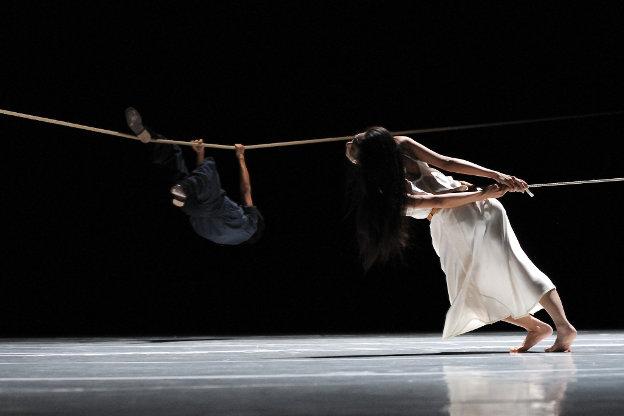As part of the World Cities 2012 series Tanztheater Wuppertal’s response to Chile is infused with a lightness of spirit. Even the name, ‘…como el musguito en la piedra, ay si, si, si…’, seems to mischievously wink at you. Take a look at a picture of ‘el muguito’ and you’ll see what I mean. Whilst the English translation ‘like moss on a stone’ may bring up rather soporific images of a carpet of green, this Chilean moss shoots off from the rock with the audacity of a punk’s Mohican; an optimistic flurry of life perched on the contours of a wasteland.
It’s a fitting image. The final World Cities piece that Pina Bausch completed before her death, this 2 hour 40 minute piece is a gloriously alive monument to the choreographer.
In this unbridled celebration of movement Bausch provides us with a vivid carousel of physical mini narratives. Whilst in keeping with her usual style of mixing dance, speech and autobiographical storytelling, what gives this piece its exuberance is the sheer level of dancing Bausch unleashes onto the stage.
Perhaps it is the warm South American air or playfully modern Chilean soundtrack, but there is a vivacious ease to …como el musguito en la piedra, ay si, si, si… that marks it apart from earlier pieces. Dancers who have been encased in structured evening wear for years are given free rein in loose summer dresses. From the off we find ourselves becoming swept up in their skirts, their bodies and free flowing hair becoming silken ribbons as they move around the stage.
For the most part it is an empty stage. Free from the large-scale set pieces with which long-time collaborator Peter Pabst usually astonishes us, it is left to the dance (and some deliciously subtle projection) to do the talking. There’s something deeply affecting about a lone figure moving in such an expansively empty space. This affinity is all the more potent with choreography that has its genesis in everyday movements. With her eerily simple repetitions, curves of each arm, limp flicks of the hand, sharp turns and low sighs Bausch manages to imbue each action with the feeling that in these prosaic moments you are glimpsing something bigger, a universal human truth.
But I’ve become too pompous. At every moment Bausch asks us to laugh at ourselves, delighting in pulling this rug of sacred thread from under us. At one point a chorus of girls and men lie on their tummies performing a ritual which leads to a courtship and returns to the floor. It looks effortless, graceful, beautiful. At the end the music stops and we hear the counting, the unsteady breath of these athletes; the water disappears and we see the frantically moving legs of the swan. Life is always a struggle Bausch invites us to acknowledge, but the struggle is always worth it.
…como el musguito en la piedra, ay si, si, si… again reveals Bausch’s fascination with sexual politics, her choreography moving fluidly from boldly drawn solos to passionate couplets. The women are beautiful, merry but sad; the men powerful, forbidding and cheeky. They play together and taunt one another. But though this is a continuation from earlier works, the balance between the sexes is closer in Chile than ever before, a truce seems to have been called.
Here women control the hearts of fickle men with knowing winks; a red headed temptress flings her arm up only to let it drop languidly into the eager palm of her suitor, repeating it again and again at her leisure. A girl gently curls onto the floor inviting her partner to lie with her cheek to cheek, only to slide away when he arrives, beginning a gentle game of cat and mouse that the mouse determinedly controls.
But for all its joie de vivre and apparent equanimity, Bausch’s disturbing darkness has not quite dissipated. She begins and ends the performance with a woman being lifted and flung from man to man, her limp body becoming just an object to be taken and given. It speaks strongly of friction and violence, of movement as a weapon. For all of the joy that marks …como el musguito en la piedra, ay si, si, si… this is the image Bausch begins and leaves us with.
…como el musguito en la piedra, ay si, si, si… is not the work of an innocent school girl blindly humming ‘What a Wonderful World’. But its invigorating and hopeful energy is breathtaking. In a piece which is a poignant reminder of just what the arts world has lost, you are at least left with one happy certainty; by the end of her life Bausch was a woman at peace with her demons.


